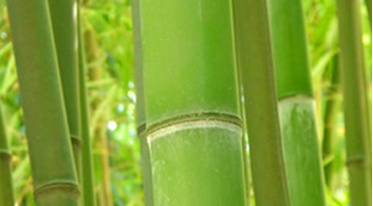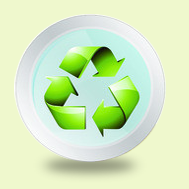|
| Bamboo |
| In China the bamboo forests are largely very well managed according to a well founded agronomic practice, even those on remote mountainsides. Every year, every new culm is marked with its year of emergence so that it can subsequently be harvested in the right year to yield timber of the best possible quality. |
|
 |
|
| |
 |
|
| Bamboo Fibre & Bamboo Yarn |
“Bamboo fibre comes from nature, and completely returns to nature in the end” Bamboo fibre is made from bamboo timber which has matured in the forest for at least 4 years. Even in remote areas of China bamboo forests are highly valued and carefully tended and managed. In summer, when new shoots reach their full height, they are marked with a year code which makes sure they are harvested at the right maturity. When harvested they are taken to mills where they are crushed and submersed in a strong solution of sodium hydroxide which dissolves the bamboo cellulose. With the addition of carbon disulfide it renders the mix ready to regenerate fibres which are then drawn off, washed and bleached to a bright white colour and dried. The resultant fluff is very long in staple and visibly finer than other fibres.
Bamboo fibre is spun into yarn, like any other textile fibre. The longer staple and higher tensile strength is what makes a tough, soft yarn – which is not as susceptible to wearing and fraying as many other yarns. This is what gives bamboo yarn excellent durability. The hollowness of the fibre contributes to its very high level of absorbency. But it also takes longer to dry on a clothesline. The hollowness of the fibre also enables it to hold dyes and pigments more readily and permanently, thus making it much more colourfast.
Bamboo yarns and textiles are produced without the use of dangerous toxic chemicals and no polluting residues remain in the cloth when it finally wears out and is discarded. It comes from nature and is returned to nature in a smooth natural cycle. It has been grown and husbanded for thousands of years and can continue to be husbanded for many more thousand years without environmental degradation. This is what is meant by complete sustainability. Very few crops can make this claim. |
|
|
| |
| The Many Advantages of Bamboo Textile Products |
 |
It’s a common fact that bamboo can thrive naturally without using any pesticide. It is seldom eaten by pests or infected by pathogens. Why? Scientists found that bamboo owns a unique anti-bacteria bio-agent named “bamboo Kun”. This substance combined with the bamboo cellulose blend tightly during the process of being produced into bamboo fibre keeping those nasty pests away!
Bamboo fibre has particular and natural functions of anti-bacteria and deodorization it is validated by the Japanese Textile Inspection Association that, even after fifty times of washing, bamboo fibre fabric still possesses excellent functions of anti-bacteria. The test results show over 70% eradication rate after bacteria being incubated on bamboo fibre fabric.
Bamboo fibre’s natural anti-bacteria function differs greatly from that of chemical antimicrobial, the latter often tends to cause skin allergies when added to apparel. |
|
 |
Some people have much more smelly feet than most because they shed more dead cells from their feet than others or they have specific personal bacteria which give off that offensive smell. Though no less hygienic than others, their feet just pong! We have not found a single customer who has not been instantly cured of this condition through wearing our textile products made from bamboo fibre
When a bamboo fibre fabric is worn against the skin:
– Any moisture (sweat) is immediately absorbed and taken away from the skin
– The powerful natural anti-bacterial property of the bamboo constantly keeps bacteria populations in check. |
|
 |
As a regenerated cellulose fibre, bamboo fibre is 100% made from bamboo through a high-tech manufacturing process. The raw material bamboo is carefully selected from 3-4 year old new bamboo plants in a non-polluted region in Yunnan and Sicuan Province, People’s Republic of China. Bamboo fibre is a biodegradable textile material. As a natural cellulose fibre, it can be 100% biodegraded in soil by micro-organisms and natural sunlight. The decomposition process does not cause any pollution to the environment. Therefore, bamboo fibre is praised as “the natural, green, and eco-friendly new-type textile material of 21st century”
The whole distilling and producing process in our plant is green process without any pollution. Yumax Bamboo manufactures bamboo fibre strictly according to ISO: 9000 and ISO 14000. We produce natural and eco-friendly fibres without any chemical additives.
|
|
 |
What’s notable about bamboo fibre is its unusual breath-ability. Because the cross-section of the bamboo fibre is filled with various micro-gaps and micro-holes, it has much better moisture absorption and ventilation capabilities. With this unparalleled micro-structure, bamboo fibre apparel can absorb and evaporate human heat in a split second.
Just like breathing, such garments make people feel warm in winter while cool in summer. It never sticks to skin even in the hot summer. Because people feel comfortable and it is very absorptive, apparel made from bamboo fibre is crowned as ‘Air Conditioning Dress’. |
|
|
|
| |
|
address:2207-2208 North Unit, Central Park Square, Building 27 Zhong Nan Century City, No. 10 Tao Yuan Road, Chongchuan District, Nantong, Jiangsu, China
Email: ntyumax@163.com xmddwb123@sina.com / Mob: +86-15720773999 +86-13862952501 /
Wechat: GIANTJENNY
|
| Copyright © 2015 - 2020 Yumax Bamboo Textiles Co., Ltd. |
|
|